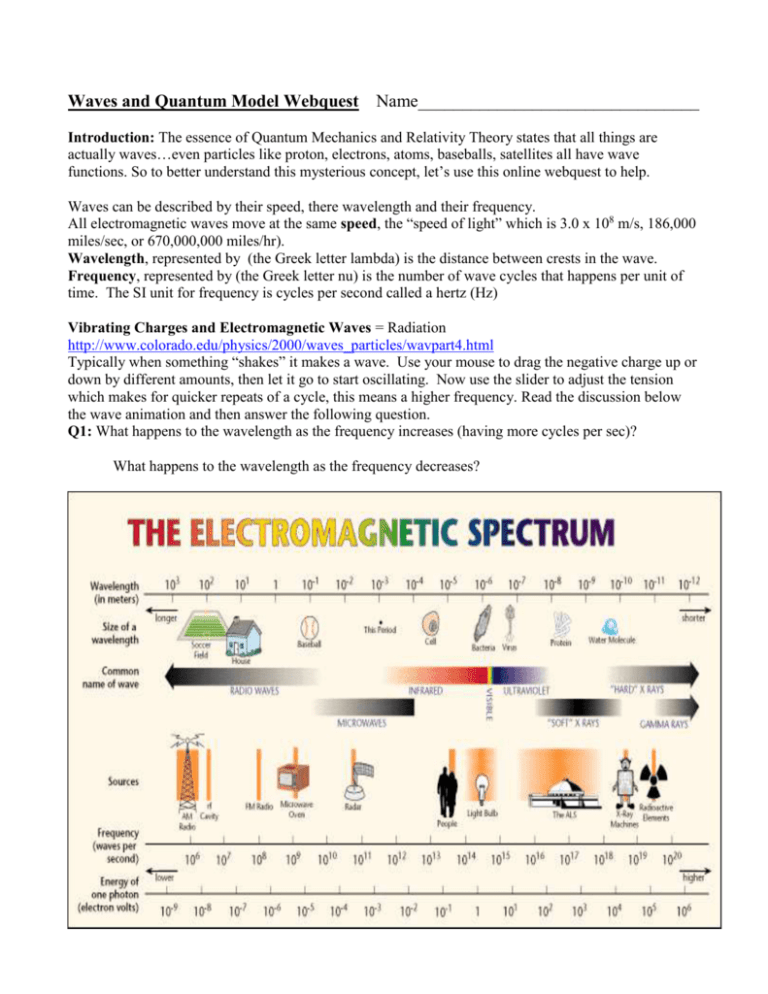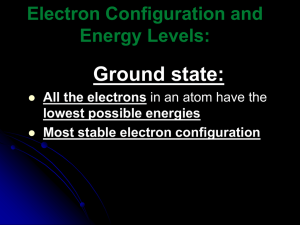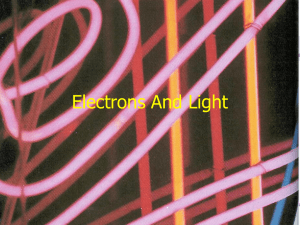Waves, Spectral Lines, Bohr and Quantum Model Webquest
advertisement

Waves and Quantum Model Webquest Name________________________________ Introduction: The essence of Quantum Mechanics and Relativity Theory states that all things are actually waves…even particles like proton, electrons, atoms, baseballs, satellites all have wave functions. So to better understand this mysterious concept, let’s use this online webquest to help. Waves can be described by their speed, there wavelength and their frequency. All electromagnetic waves move at the same speed, the “speed of light” which is 3.0 x 108 m/s, 186,000 miles/sec, or 670,000,000 miles/hr). Wavelength, represented by (the Greek letter lambda) is the distance between crests in the wave. Frequency, represented by (the Greek letter nu) is the number of wave cycles that happens per unit of time. The SI unit for frequency is cycles per second called a hertz (Hz) Vibrating Charges and Electromagnetic Waves = Radiation http://www.colorado.edu/physics/2000/waves_particles/wavpart4.html Typically when something “shakes” it makes a wave. Use your mouse to drag the negative charge up or down by different amounts, then let it go to start oscillating. Now use the slider to adjust the tension which makes for quicker repeats of a cycle, this means a higher frequency. Read the discussion below the wave animation and then answer the following question. Q1: What happens to the wavelength as the frequency increases (having more cycles per sec)? What happens to the wavelength as the frequency decreases? The Electromagnetic Spectrum (ask Mr. Jasmann to play you the The Electromagnetic Spectrum Song - by Emerson & Wong Yann for a good intro to EM Spectrum) Momentarily use the chart above for the next questions, then revert back to the webpage. Q2: Using the chart above, answer the following questions. List the 8 common names of electromagnetic radiation in order of longest to shortest WAVELENGTH. Q3: Which type electromagnetic wave has a wavelength that is about 10m to 1000m long? Q4: What are the two types of waves that have the highest energy per photon? Do you think this has a correlation to possible cell damage to humans? Explain why you’d think that. Q5: What is the relationship between the frequencies and energy content of the waves? Q6: Which waves are the human eyes able to detect or see? In your opinion, is this a large or small part of the entire possibility of photon types (the entire electromagnetic spectrum)? Back to the webpage…click on the “Quantum atom” link on the bottom right of the page which connects… Spectral Lines at http://www.colorado.edu/physics/2000/quantumzone/index.html Read this entire page and answer the following questions. Q7: Physicists know that heating things causes the atoms to “wiggle”. What is ejected from atoms when they wiggle? Q8. Use the spectral line changer to view the visible spectral lines of at least 4 or 5 elements. Now describe what spectral lines are in your own words? And why is it they could be described as “signatures” or “fingerprints” of elements. Click on the “Next” button which connects to… Bohr’s atom http://www.colorado.edu/physics/2000/quantumzone/bohr.html Q9: Define photons and quanta. How does this relate the “Quantum” Mechanical model of the atom as we know today based upon the discoveries of Neils Bohr. Click on the “Next” button which connects to… Energy Levels http://www.colorado.edu/physics/2000/quantumzone/bohr2.html We modified Bohr’s ideas to say that Bigger Orbits have higher energy electrons, so we now call the rings of electrons located different distances away from the nucleus “Energy Levels”. Q10: Describe what is required to allow an electron to jump to a high energy level? Q11: Describe what happens when an electron returns to its lower energy level? Click on the “Next button which connects to… Atomic Spectra at http://www.colorado.edu/physics/2000/quantumzone/lines2.html Atomic Spectra are the “signature” spectral lines released by specific atoms. Specific wavelengths are released by each atom because only specific “jumps” between that atom’s energy levels can occur. Experiment with jumping the electron in the Hydrogen atom to outer and inner orbits to see what happens with the photons absorbed or released. Q12: If you make the electron jump downward, then return it to the outer ring what do you notice about the photon released or absorbed? Q13: Start with the electron being highly energized in the outermost shell. Now click to allow it to drop to each of the lower energy level one at a time. What happens….why are three new spectral lines formed on the chart? Click on “Making X-rays” button at the bottom which connects to… Making X-rays at http://www.colorado.edu/physics/2000/xray/making_xrays.html Q14: Use this page and your own intuition of what was just learned to explain how we make X-rays (a very high energy photon of light) emit from Tungsten (a large atom with very high energy level orbitals). Now click the “Back” button at the top of your browser page to return to Atomic Spectra page This time click on the “Heavier Atoms” link, then “Next” then find the “Periodic Table Applet” to click on which brings you to David’s Whizzy Periodic Table at http://www.colorado.edu/physics/2000/applets/a2.html This interactive periodic table shows the first 4 periods (rows) of the periodic table. Notice that the atomic emission spectrum of each element is also shown for each element as you click on them in the table. The Bohr-type model on the left will also change with the pink dots representing electrons in the 1st energy level, the yellow dots representing the 2nd energy level electrons, green dots the 3rd, etc. We will ignore the right side showing the ionization energy for now, but basically this will show that is always requires the least amount of energy (around 10 eV, electronvolts) to remove which ever is the outermost electron. Click on 7 different elements to get an idea of what changes each time, just explore. Q15: Now click on Li, lithium. Click on the “Nucleus View” and describe what you think is represented there? Q16: Now click on the “Shell View” for Lithium and describe what you see in the left diagram? Be specific about what the pink and yellow dots represent. Q17: Normal Lithium has an atomic # of 3 and a mass # of 7amu. Do the diagram views agree with this? explain. Q18: Notice the atomic emission spectrum for Li, what color spectral lines does Li emit? Q19: In order, click on the following elements: H, He, Li, Be, C, N, O, Cl, Ne, then Na, Mg. Describe what happens every time you proceed down the horizontal row or period. What happens when you jump down to the next row? Check out a few more and see if your pattern continues. Q20: In order click H, Li, Na, K. Count the number of electrons in each energy level as you go down this family or group. Remember from 1st (inner) to 4th (outer) energy level the colors go from pink to yellow to green to aquamarine. What is similar about the number of valence electrons in each and what is different about which energy level the valence e- is/are found in? Hint: you can summarize the number of electrons in Na saying there are 2-8-1 in the 1st-2nd-3rd energy levels respectively. Q21: In order click on He, Ne, Ar, Kr. What is similar about the number of valence electrons in each and what is different about which energy level the valence e- is/are found in? Q22: Notice that the sublevels of the electrons are listed on the right as s, p and d. You will learn later what these mean, but for down that within each Energy Level these are 3 of the possible patterns or sublevels that electrons can be in. Click on the largest atom shown Kr which has all of its Energy Levels and sublevels maxed out. Count and list the maximum number of electrons found within each of these 3 sublevels: s, p and d. Now check around on other elements on the chart to make sure that none have more than this in any of their sublevels. Q23: PREDICT before looking….what will be the similarities and differences in electron locations as you click on F, Cl, Br? Now do it and see if your prediction is right. Q24: Click on He- Li then Ne-Na and then Ar-K. Describe the general trend of what happens to the next electron added after each Noble gas. Q25: What is special about He, Ne and Ar in regarding to the “octet rule” of bonding (and electron transfer)? These elements have been referred to as “inert” which means unreactive. This means they do not accept or give away electrons. Explain why this would be the case. Q26: Li, Na and K are likely to lose an electron. Why is this the case based upon the octet rule? What electron would they lose (Be Specific)? Li _____ Na ______ K ____ After losing this electron, what elements would their energy levels be identical to? Q27: O, S, and Se are likely to gain two electrons. Why is this the case based upon the octet rule? Where would the two new electrons go (Be Specific)? After gaining these two electrons, what elements would their energy levels be identical to? O _____ S ______ Se ____ Q28: Based on the examples you just did try to PREDICT before looking….how many electrons would be lost or gained by Mg and by F. And what elements would their energy levels be identical to for each after losing or gaining the electron(s)? Now check to see if you were right. Summary of what was learned in this webquest. Please use complete sentences for these last ones. Q29: Describe some reasons why our current understanding of the atom is known as the Quantum Model. Q30: Is there a systematic way in which the periodic table is organized that helps us to make good predictions about what the electron configurations (the location of electrons) in atoms look like? Describe some of these systematic patterns.








